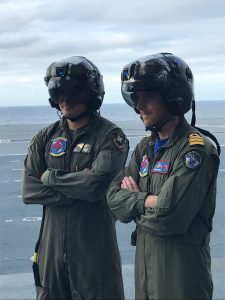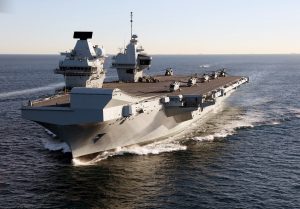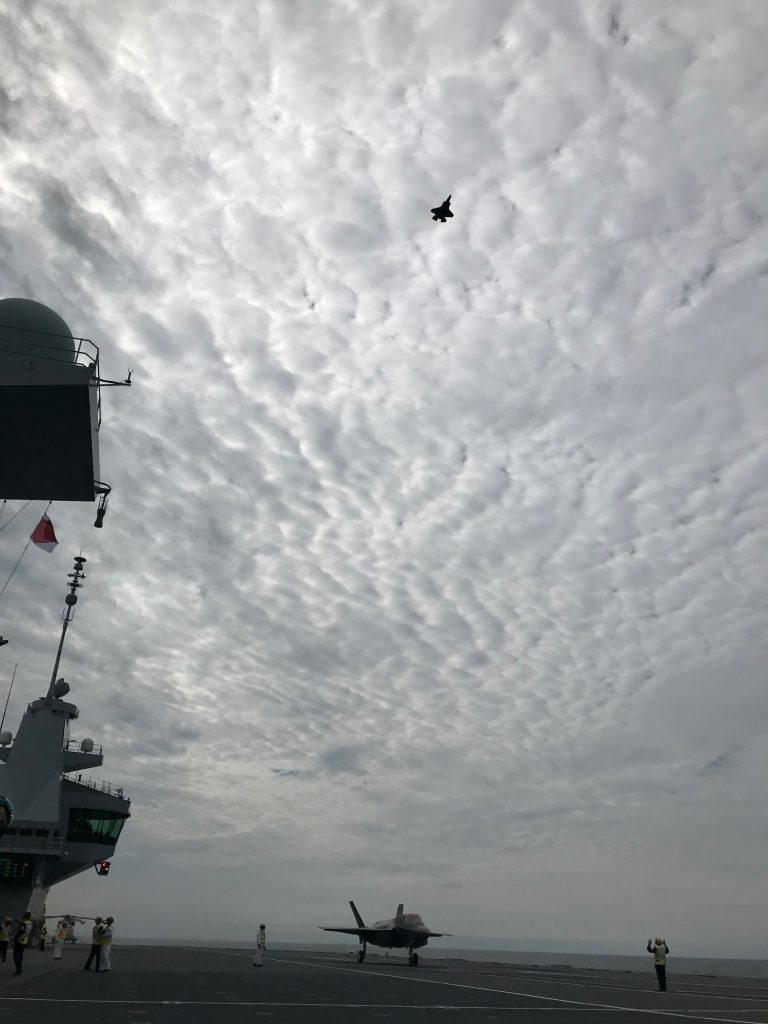Royal Navy Lands 1st F-35B on New Carrier HMS Queen Elizabeth
Posted on
ABOARD HMS QUEEN ELIZABETH: For the first time, a Royal Navy pilot has taken off and landed an F-35B on a British aircraft carrier, eight years after the UK retired its last generation of carriers.
Royal Navy Cmdr. Nathan Gray, 41, made history on Sept. 25 by flying from Naval Air Station Patuxent River, Maryland to the carrier, landing, and then taking off using the ship’s ski-ramp. (All news and media about the flight was embargoed until this evening by the British.)
The QE will spend the next two months plying the waters off the East Coast improving its prowess with F-35B carrier landings and training its crew. The ship will return in late 2019 for more intense operational testing, and is slated to fully deploy in 2021. That mission — the first time a British carrier has patrolled at sea since 2010 — will be followed two years later by the HMS Prince of Wales, bringing to a close a gap in carrier capability that Britain has experienced since retirement of the Invincible and Ark Royal.
“This is a proper strategic asset,” Capt. Jerry Kyd, commander of the carrier, told a small group of reporters flown aboard this week.
The Queen Elizabeth was built explicitly to fly the F-35, and UK Carrier Strike Group Commodore Andrew Betton told reporters that “this is the first time anywhere in the world we have brought together a 5th Gen fighter with a 5th Gen aircraft carrier.”
British pilots and sailors have deployed aboard American and French carriers to keep their skills sharp since their last two carriers were mothballed, and Royal Air Force and navy pilots have been involved in the F-35 program since its inception.
But working without their own carriers for close to a decade has meant there are still some muscle memory functions that sailors need to work on.

Royal Navy Commander, Nathan Gray (R) was the first British pilot to take off and land on a carrier in an F-35
“We’re not going to pretend it’s easy,” Rear Adm. Keith Blount, assistant chief of the Naval Staff, told reporters. “But this isn’t unfathomably difficult for us. We are enjoying going back into the big time, and this is one of those big steps on that ladder. It’s hugely exciting and should be reassuring to those back home and to those on this side of the Atlantic.”
British naval officials all said they were looking forward to working more closely with the US and French navies once the ship is fully operational, and having another two big decks stuffed with F-35Bs will come as a welcome relief for the US Navy in particular, which is struggling with maintenance on it’s own 11-carrier fleet. The American ships have been strained over the past 17 years of war in the Middle East and growing tensions with China in the Pacific.
Although the Royal Navy doesn’t plan to deploy the carriers simultaneously, the two ships will allow the UK to project power nearly continuously overseas using a 5th generation aircraft, something only the US can do now.
Combined with the American carriers and France’s Charles De Gaulle, NATO will soon have the ability to boost its continuous “naval power projection in the Mediterranean or east of the Suez Canal,” said Bryan Clark, a naval expert with the Center for Strategic and Budgetary Assessments. “Given the US shift to dynamic force employment and a focus on great powers, the contribution from the Royal Navy could help maintain a continuous carrier presence in the Middle East.”
Betton said that the move from old carriers with their Harrier jets to the new carrier and the F-35B is profound, and “integrating the sensors of all the platforms is quite challenging,” but they’re taking it in increments.
“The focus is very much establishing an operating envelope for the jet, but we’re trying to take every opportunity we can to expand our carrier strike group muscle memory — we used to do this a lot in the UK — but we’re getting back into the carrier strike business working alongside our French and US partners.”

The new Royal Navy carrier HMS Queen Elizabeth off Gibraltar. Note the prominent “ski jump” on the bow to allow launching of short-takeoff aircraft like the F-35B.
In 2019, plans call for the Queen Elizabeth to be outfitted with the anti-missile Phalanx weapons system and be equipped with its new communications equipment. By September, the ship will undergo another round of testing with seven aircraft aboard, and by 2020 the entire strike group including the Marine Crops’ VMA-211 attack squadron, will conduct more tests focused on integrating all the of the pieces.
This week’s milestone comes the same week as a US Marine Corps F-35B bombed a target in combat in Afghanistan for the first time. On Friday, another Marine JSF crashed in South Carolina. The pilot survived and the cause of the accident is under investigation.
Kyd, who commanded both the Illustrious and the Ark Royal, said that the UK’s return to carrier ops will have a profound effect not only on the military and NATO allies, but the country’s politics as well. “She’s definitely our conventional strategic asset that counterbalances the nuclear submarines we have,” he said, “The awakening in the political class that this sends a political message when she sails is important, and that’s new to us.”
Subscribe to our newsletter
Promotions, new products and sales. Directly to your inbox.

